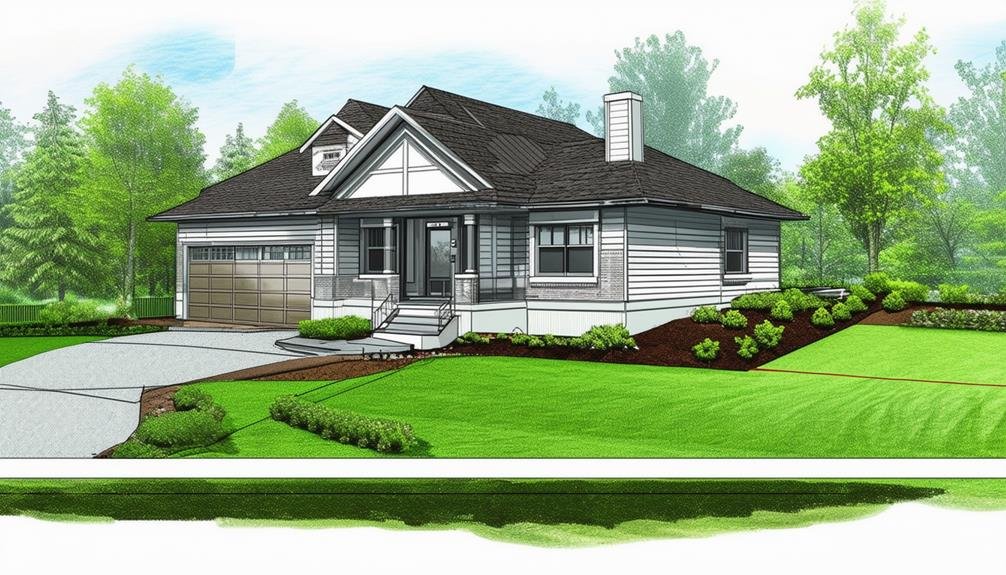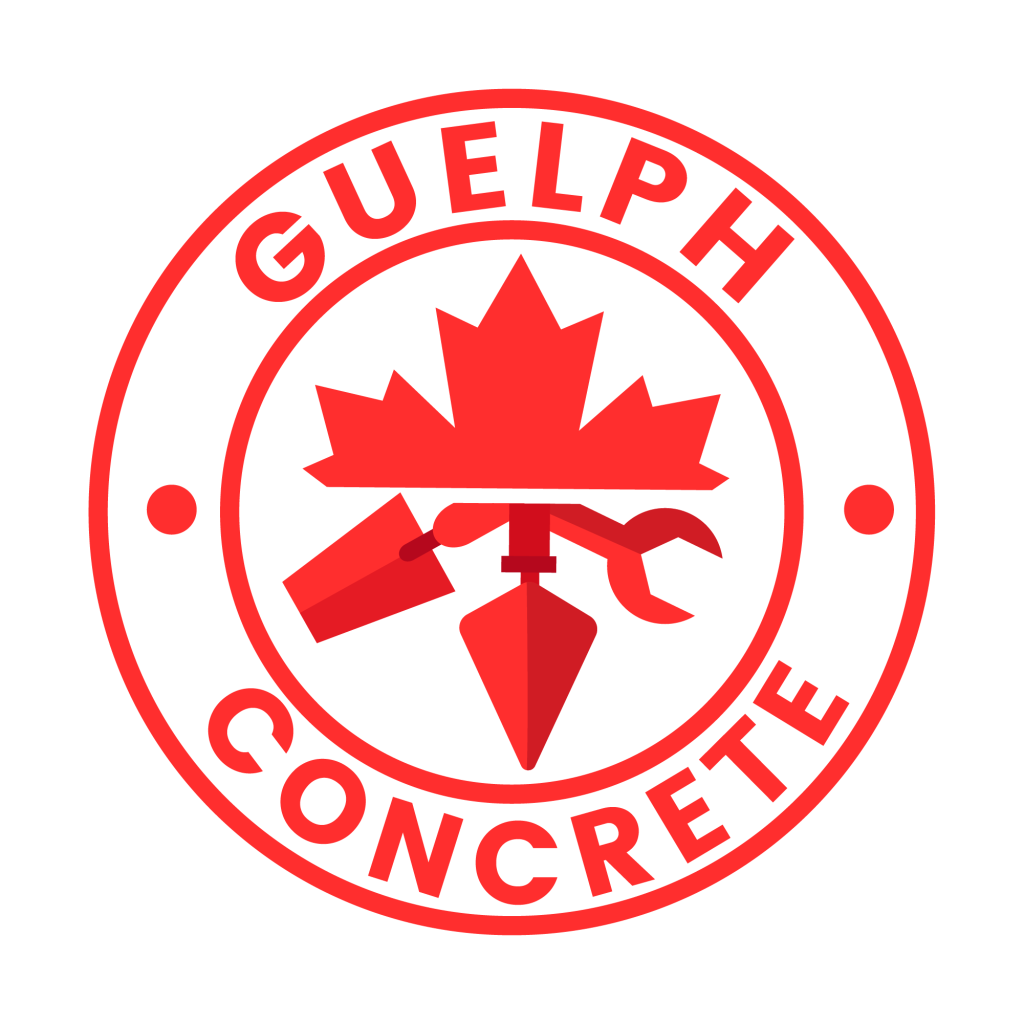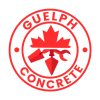At Guelph Concrete LTD, with over 15 years of experience in Guelph, Ontario, we understand the importance of a waterproof foundation. Here’s our proven method for waterproofing a foundation from the outside:
- Evaluate the Foundation: Our first step is to assess the foundation’s condition for any cracks and water damage.
- Excavation: We meticulously excavate around the foundation to prepare for the waterproofing process.
- Cleaning: Using a pressure washer and specialized cleaning solution, we thoroughly cleanse the foundation to ensure a clean surface for the waterproof coating.
- Apply Waterproof Coating: We apply a durable waterproof coating, like Bakor WP200, ensuring all cracks are sealed effectively.
- Install Drainage Layer: Installing a suitable drainage layer is crucial. We use high-quality backfill materials such as gravel and geotextile fabric to facilitate proper drainage.
- Proper Grading: We ensure that the grading around your foundation slopes away from the structure, preventing water accumulation.
- Additional Measures: To further protect your foundation, we recommend keeping gutters clean and installing a sump pump if necessary.
For a more detailed explanation and practical tips tailored to your specific needs, contact Guelph Concrete LTD for a free estimate. Call us today at 548-490-2074 and let our experts help you safeguard your home with our reliable waterproofing solutions.
Assessing Foundation Condition
To effectively evaluate a foundation’s condition, we need to look for visible signs like cracks, water stains, or mold growth. These indicators help us grasp the present state of the foundation and identify any potential issues that might demand immediate attention. By thoroughly inspecting for these signs, we can uncover structural weaknesses or areas of vulnerability that might compromise our home’s integrity.
Evaluating foundation strength is important. We should carefully examine all parts of the foundation, paying close attention to any cracks or uneven surfaces. Even small cracks can be significant, as they might indicate underlying problems. Additionally, we need to check for signs of water infiltration. Moisture detection techniques, such as looking for damp spots or efflorescence on the walls, can reveal hidden water issues.
It’s often wise to hire a professional for a thorough assessment. Experts can provide a detailed analysis of the foundation’s waterproofing needs, making sure we don’t overlook anything important. Understanding the foundation’s current state is crucial for determining the extent of waterproofing required.
Excavation Process

How do we start the waterproofing process? The answer lies in a thorough excavation process. We need to dig around the foundation to expose it fully. This step is crucial because it allows us to inspect for any existing damage or cracks before applying the necessary waterproofing materials.
To achieve this, we rely on heavy machinery like excavators and backhoes, which ensure the excavation process efficiency. It’s vital to work with skilled operators who prioritize excavation safety, as this involves deep and precise digging.
Here’s a quick rundown of what we do:
- Use heavy machinery: Excavators and backhoes make the digging process faster and more efficient.
- Inspect thoroughly: Once exposed, we can check the foundation for any damage.
- Ensure proper depth: Digging to the correct excavation depth is crucial for adequate coverage and protection.
- Maintain safety: We follow strict excavation safety protocols to protect our team and the property.
- Prepare for waterproofing: Exposing the foundation allows us to apply sealants and membranes effectively.
Foundation Cleaning

Once we’ve finished the excavation, we proceed to cleaning the foundation to secure a pristine surface for waterproofing. This step is crucial because a clean foundation guarantees that our waterproofing materials adhere properly, providing long-lasting protection.
We start with pressure washing, one of the most efficient cleaning techniques to eliminate dirt, debris, mold, and mildew. If you don’t have access to a pressure washer, scrubbing the foundation with a cleaning solution and a stiff brush works well too. We suggest using a mixture of water and trisodium phosphate (TSP) for this purpose. TSP is outstanding for addressing stubborn stains and efflorescence, which is the white, powdery residue often found on concrete.
During the cleaning process, it’s important to be meticulous. Any remaining contaminants can jeopardize the adhesion of the waterproofing membrane or coating. We pay extra attention to cracks and crevices, making sure they’re free of debris.
Furthermore, a good practice is to rinse the foundation with clean water after scrubbing to eliminate any residual cleaning solution. This step prepares the surface for a smooth application of waterproofing materials, setting the stage for the next phase of our project.
Applying Waterproof Coating

At Guelph Concrete LTD, we’ve been safeguarding the foundations of homes and businesses in Guelph, Ontario for over 15 years.
Today, let’s walk through the essentials of applying waterproof coating to your foundations. We’ll cover the key steps for surface preparation, how to choose the right waterproof coatings like Bakor WP200, and the best techniques to guarantee a watertight seal.
This process is vital for protecting your foundations from water damage in Guelph, Ontario.
Don’t leave your foundation to chance. Contact Guelph Concrete LTD for a free estimate. Call us today at 548-490-2074.
Surface Preparation Steps
Before applying the waterproof coating, we must thoroughly clean the foundation surface to remove any dirt, debris, or contaminants. This guarantees that the coating adheres properly and provides the best possible protection.
To get started, here are some surface preparation techniques we need to follow:
- Clear the area: Eliminate any loose dirt, leaves, or debris from around the foundation.
- Wash the surface: Utilize a pressure washer to clean the foundation walls, eliminating any stubborn grime or residue.
- Repair cracks: Fill any cracks or imperfections with a high-quality sealant to prevent water infiltration through the coating.
- Scrape off old material: Eliminate any existing paint, tar, or old waterproofing products that might interfere with the new coating.
- Dry the surface: Ensure the foundation is completely dry before applying the waterproof coating.
Choosing Waterproof Coatings
Selecting the appropriate waterproof coating is crucial for ensuring our foundation stays dry and protected from moisture damage. In Guelph, we often turn to reliable waterproofing materials like Bakor WP200 for small exterior foundation projects. This product is known for its durability and comes with a manufacturer’s guarantee, giving us peace of mind that our foundation will be well-protected.
To enhance water drainage and add an extra layer of protection, we can also use Bakor WP 2000 water drainage and protection board. This combination guarantees that our exterior foundation benefits from thorough moisture defense. By carefully choosing these waterproofing materials, we can substantially extend the life of our foundation and avoid costly repairs down the road.
Here’s a quick look at the benefits of these materials:
| Waterproofing Material | Protection Benefits |
|---|---|
| Bakor WP200 | Sturdy, reliable waterproofing |
| Bakor WP 2000 | Improved water drainage |
| Manufacturer’s Guarantee | Quality assurance and reliability |
Choosing the right coating isn’t just a task; it’s an investment in the longevity of our home’s foundation. By using products like Bakor WP200 and WP 2000, we’re not just protecting against water entry—we’re safeguarding our home’s future for years to come.
Application Techniques Explained
Now that we’ve selected our waterproof coatings, it’s time to understand the best techniques for applying them to guarantee maximum protection for our foundation. Proper application is the cornerstone of effective waterproofing, making sure our home is shielded from moisture and water damage.
First, we need to prepare the foundation surface by cleaning it thoroughly. Any dirt, debris, or old paint must be removed to make certain the waterproof coating adheres properly.
Next, we apply Bakor WP200 using a roller or sprayer, ensuring an even, continuous layer. Let’s not rush; it’s vital to avoid gaps or thin spots.
Here are the key steps to visualize:
- Surface Preparation: Clean and dry the foundation.
- Application of First Layer: Use a roller or sprayer for an even coat.
- Drying Time: Allow the first layer to fully dry before proceeding.
- Installing the Protection Board: Place Bakor WP2000 over the dried coating.
- Final Check: Inspect for any missed spots or inconsistencies.
Installing Drainage System

Excavating around the foundation to install weeping tiles is necessary for effectively redirecting water and prevent it from entering your home. Let’s break down this process together.
Once we’ve dug around the foundation, we place the weeping tiles—a series of perforated pipes—near the footing. These tiles play a vital role in collecting water and directing it away from the foundation, ensuring your basement stays dry.
We want to make sure these weeping tiles are installed correctly to ensure efficient water drainage. The tiles should slope slightly downward to guide water into a sump pit or the sewer system. This setup is a fundamental component in exterior foundation waterproofing, protecting your home against water damage.
It’s equally important to take into account drainage system maintenance. Regularly check for any blockages or damage in the weeping tiles. Weeping tile troubleshooting involves inspecting these tiles for clogs, sediment buildup, or cracks. Addressing these issues promptly can prevent more significant problems down the line.
Backfilling Techniques

Now that we’ve installed your drainage system, let’s focus on backfilling techniques to ensure your foundation remains strong and dry.
At Guelph Concrete LTD, we’ve been serving the Guelph, Ontario community for over 15 years, and we know that proper soil compaction methods, the importance of a drainage layer, and selecting the appropriate backfill materials are crucial steps.
These measures are essential for maintaining the integrity of your waterproofing system and preventing future issues.
If you want your backfilling done right, trust the experts. Contact Guelph Concrete LTD for a free estimate today at 548-490-2074.
Proper Soil Compaction Methods
Proper soil compaction during backfilling is vital to prevent settlement and maintain our foundation’s stability and strength. The significance of compaction methods can’t be overstated. If we don’t compact the soil properly, we risk uneven settling, which can lead to structural issues and compromise the foundation’s integrity.
Choosing the right compaction equipment is essential. Here are some key steps and considerations to guide us through proper soil compaction:
- Layering: Backfill in small layers, typically 6-8 inches thick, to guarantee each layer is compacted thoroughly.
- Compaction Tools: Use appropriate equipment like plate compactors or vibratory rollers depending on the soil type and project scale.
- Uniform Compaction: Ensure even and uniform compaction around the entire foundation to distribute loads evenly and minimize potential damage.
- Moisture Content: Maintain the right moisture content in the soil to achieve best compaction.
- Testing: Regularly test compaction levels using methods like the Proctor test to guarantee the desired density is achieved.
Importance of Drainage Layer
Why is a drainage layer so important when backfilling around our foundation? Simply put, it’s essential for preventing water accumulation against our foundation walls. When we backfill with a proper drainage layer, like gravel, we create an effective barrier that promotes water flow away from the foundation. This water diversion minimizes the risk of water seeping into our basement or crawl space, keeping our foundation dry and stable.
Installing a drainage layer isn’t just about moving water; it also notably reduces hydrostatic pressure on the foundation walls. Hydrostatic pressure can cause cracks and structural damage over time. By ensuring drainage effectiveness, we protect our home’s structural integrity and avoid costly repairs in the future.
In practice, backfilling with materials that facilitate drainage, such as coarse gravel, allows water to flow freely and prevents it from pooling around the foundation. This helps in maintaining a dry environment and prolongs the life of our foundation. It’s an investment in the longevity of our home, giving us peace of mind, especially during Guelph’s wet seasons.
Selecting Backfill Materials
When it comes to selecting backfill materials, we must choose options like gravel, crushed stone, and sand to guarantee excellent drainage and prevent water accumulation against our foundation. Making informed decisions in backfill selection is critical to securing our foundation’s longevity and effectiveness.
To create imagery in our minds, consider these ideal materials:
- Gravel: Large, angular pieces allow water to flow freely.
- Crushed Stone: Similar to gravel but finer, offering great drainage.
- Sand: Fine particles that fill in gaps and improve water flow.
- Pea Gravel: Smaller, rounded stones that secure stability and drainage.
- Geotextile Fabric: Helps separate soil from backfill, enhancing drainage.
In addition to selecting the right materials, we need to pay attention to compaction. Proper material compaction is essential to prevent settling and maintain the structural integrity of our foundation. If the backfilled area settles, it can lead to uneven pressure on the foundation, potentially causing cracks or other damage.
Good backfilling techniques involve layering the materials and compacting them adequately at each stage. This method ensures that we achieve the best drainage considerations and settling prevention, ultimately safeguarding our foundation from water infiltration.
Let’s take the time to choose wisely and execute effectively, creating a safer, drier home for all of us.
Ensuring Proper Grading

To guarantee water flows away from your house, we need to focus on grading the ground around the foundation correctly. Proper grading is essential in preventing water seepage into the basement and maintaining an effective drainage system.
First, let’s talk about checking slopes. We should make sure the ground slopes away from the foundation at a minimum of 1 inch per foot for the first 6 feet. This creates a natural pathway for water to flow away from the house, reducing the risk of water accumulation near the foundation.
Next, let’s explore some landscaping options. Incorporating flower beds, shrubs, and even small retaining walls can help maintain the necessary slope while enhancing the aesthetic appeal of your property.
Here’s a handy table to visualize the recommended slope:
| Distance from Foundation | Minimum Slope | Purpose |
|---|---|---|
| 1 foot | 1 inch | Initial runoff |
| 2 feet | 2 inches | Continued drainage |
| 3 feet | 3 inches | Prevent water pooling |
| 4 feet | 4 inches | Maintain water flow |
| 5-6 feet | 5-6 inches | Effective water runoff |
Regularly inspecting and adjusting the grade guarantees that it remains effective over time. By focusing on proper grading and incorporating thoughtful landscaping, we can safeguard our foundations and create a welcoming environment that’s both functional and beautiful.
Sump Pump Installation

Installing a sump pump in your basement is an important step in keeping it dry and preventing water damage. In Guelph, we typically place the pump in a pit designed to collect and remove water efficiently. This method guarantees that water is directed away from your home, reducing the risk of flooding.
When considering sump pump installation, it’s essential to understand the various waterproofing options available. Here’s what you can expect:
- Sump Pit Installation: A pit is dug in the lowest part of the basement to gather water.
- Pump Connection: The sump pump is connected to a drainage system that directs water away from your home.
- Weeping Tiles Inspection: Post-waterproofing, we make sure that weeping tiles are functioning correctly to optimize drainage.
- High-Pressure Flushing: For non-functioning weeping tiles, high-pressure contractors can flush them out.
- Pump Maintenance: Regular maintenance is important to keep the system running smoothly and prevent future issues.
Regular Maintenance Tips

Regular maintenance is necessary for ensuring the longevity and effectiveness of your home’s waterproofing systems.
First, let’s talk about effective gutter maintenance. By regularly inspecting and cleaning our gutters, we can prevent water buildup near the foundation, which is important for preventing foundation damage. Clogged gutters can cause water to overflow and pool around the base of our homes, leading to severe issues over time.
Next, it’s important to take into account the positioning of our downspouts. Ensuring that downspouts direct water away from the foundation is essential. If water is allowed to pool near the foundation, it increases the risk of leaks and structural damage.
We should also monitor the grading around our foundation. Proper grading for drainage efficiency means the ground should slope away from the house, helping to channel water away and reduce the chances of water seeping into the foundation.
Frequently Asked Questions
How Do You Waterproof a Foundation From the Outside?
To waterproof a foundation from the outside, we start with the excavation process. Next, we apply Bakor WP200 waterproofing membrane and then install drainage solutions like the Bakor WP 2000 board for enhanced protection and durability.
What Is the Best Waterproofing for Exterior Foundation?
We believe the best exterior foundation waterproofing combines drainage solutions and landscaping with exterior sealants and insulation. Using Bakor WP200 membrane and WP 2000 board guarantees long-lasting protection, keeping our homes dry and secure.
Is It Better to Waterproof Basement From Inside or Outside?
While exterior waterproofing may seem costlier initially, it prevents water entry more effectively than interior solutions. By comparing the cost and benefits of interior vs exterior waterproofing, we see long-term savings and foundation protection make exterior the better choice.
How Do You Keep Foundation Waterproof?
To maintain our foundation waterproof, we should use drainage solutions and proper landscaping to direct water away. Regular sealant application and maintenance are vital. Together, we can protect our homes and guarantee a dry, safe foundation.
Conclusion
We’ve walked you through the fundamental steps to waterproof your foundation from the outside here in Guelph, Ontario.
By comparing the peace of mind a dry basement offers to the turmoil of water damage, it’s evident that a proactive approach pays off.
From excavation to regular maintenance, each step is vital.
Let’s embrace the challenge and protect our homes, ensuring longevity and comfort for years to come.
Your foundation deserves nothing less.


